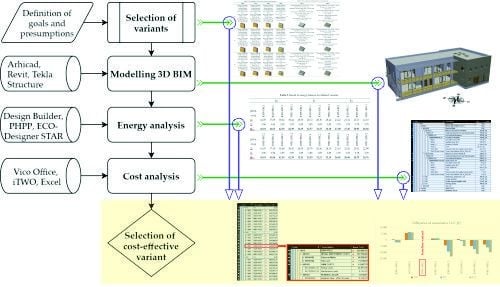Energy and Cost Analysis of Building Envelope Components Using BIM: A Systematic Approach †
Abstract
:1. Introduction
2. Materials and Methods
2.1. Modelling 3D BIM
2.2. Energy Analysis
2.3. Cost Analysis
3. Case Study
3.1. Description of the Building
3.2. Building Modelling with BIM Approach
3.3. Description of Analysed Envelope Components and Combinations
- The calculations of U-values of each variant consider real dimensions of deliverable thickness of the thermal isolation, where defined or better border limits are regarded;
- The principles for the outer side and inside of external walls and a roof are similar;
- The difference of the outer side of both elements is only in the thickness of the used thermal isolation according to three different defined U-values;
- Other key elements of building envelope do not change;
- Data on thermal conductivity for the internal finish plaster, RC wall, RC roof slab, the façade finishing system (external wall plaster), and roofing (PE foil, gravel, vapor permeable foil, waterproofing) are taken from the Technical guidelines TSG-1-004 Efficient use of energy [53];
- Structural design and systems of structural elements take into consideration the established design documentation [52].
3.4. Calculation of the Energy Balance
- Occupancy of the premises: people 100%;
- Minimum indoor temperature in heating period 22 °C;
- Maximal indoor temperature in cooling period 25 °C;
- Internal gains Qi = 2.8 W/m2;
- Net heated floor area Ah = 695.68 m2 and net heated volume Vh = 2644.00 m3, internal height (for each floor) Hh = 3.80 m;
- Glazing-to-wall area ratio (AGAW): AGAWsouth = 33.0%, AGAWnorth = 24.4%, AGAWwest = 1.3%, AGAWeast = 22.5%;
- Air change rate at press. test (air test of 50 Pa) n50 = 0.60 h−1 (according to PHI [59]);
- Relative humidity (RH) humidification setpoint: 10% and RH dehumidification setpoint: 90%;
- Minimum average sum of natural, mechanical, and infiltration air change rate according to [60]: 0.5 h−1; average air change rate with natural and mechanical ventilation together with infiltration is 0.87 h−1.
3.5. Cost Analysis
- Initial investment costs: in general, these costs include costs for activities of preconstruction phases and costs for construction of the building. In our case study, only costs for erecting all components of external walls and the flat roof are regarded. Therefore, these costs are calculated according to the principle of the unit price for all items needed to complete the whole component. Calculations of a unit price are based on predefined construction technology and geometric characteristics of the element. They utilize the norms for construction (masonry, reinforced concrete works, formworks, plaster) and craft works (façade and painting works) [54,55,56,61,62], and the average price of labour [63] and market price of materials per unit of measure [62,63,64,65,66,67,68]. Prices for some items are given according to the average market prices; all without VAT. Figure 3a) shows the initial investment costs per square meter of net heated floor area (Ah) for all variants. Costs for all preconstruction phases and construction of other building components as well as costs for installing window and door lintels are not analysed because we assume that they are the same in all variants. We also made preliminary calculations for all initial investment costs of construction (including construction, craft and installation works) for the basic variant of the building (as described in the chapter 3.1) and it does not include the values for the external wall and flat roof systems, totalling 665,504.42 € [69].
- O&M costs: In general, these are annual running costs throughout the lifespan of the building divided into a) maintenance costs as total of incurred labour, material, and other related costs to maintain the building or its parts in an adequate state to perform its required functions; and b) operation costs that include running costs and costs of the facility management, involving administrative support services (e.g., rent, rates, insurances, energy, and other environmental/regulatory inspection costs, local taxes and charges) [49]. Our case study considers maintenance costs as the costs that are required to keep the utility and the value of the walls and a roof, namely, façade components for the wall and upper layers of the roofing for a flat roof. Maintenance tasks for the normal service life of the façade include regular repairs of mechanically damaged plaster, and regular maintenance of hanging gutters, roof drain pipes, and window sills (washing and cleaning to prevent soaking and dirt of the facade) while the tasks for roof maintenance include regular maintenance and inspections, cleaning of drainage shafts on the roof, and regular care prevent mechanical damage to the insulation (e.g., during new interventions). Maintenance costs also include the replacement of individual worn-out elements after the end of their service life. Further, energy costs for space heating and cooling are taken into account as operating costs. Figure 3b) shows the O&M costs per square meter of net heated floor area (Ah) for all variants. The calculation of O&M cost considers the following assumptions:
- Maintenance costs include regular maintenance of a lesser value and maintenance cost, which is taken into account only for the elements for which service life expires in the relevant study period and which are intended for reimplementation;
- Maintenance costs are evaluated against the linear function for physical deterioration of the building element’s condition;
- Values of regular maintenance are summarized by national rules [70] and represent the fraction of small repairs (in %) to new value;
- The reimplementation of the element in the 20 years is considered for variants of combinations with roofing FRC1 while the component has a shorter service life as a study period. To simplify the presentation of costs on an annual basis, they are spread over all years of the study period;
- Building annual energy end use for the conditioned floor area is for all treated variants provided by whole building energy simulations run in DesignBuilder 4.5 [57] through its simulation module;
- Annual energy costs are provided via estimation of future energy costs based on utility rates for electricity;
- Utility rates for electricity are obtained from the building operator, totalling 0.138 €/kWh, and representing the increased cost in kWh (including taxes and charges) of electricity consumption in 2018, which was the first year of the full operation;
- The annual increase of maintenance costs and energy price forecasts are embodied in the discounting of maintenance and electricity costs over the study period;
- Other maintenance costs and operating costs (such as insurance, local taxes, and local charges) are neglected because they do not play any important role in the relation to the energy costs and they are the same for all variants and thus have no influence on decision-making.
When estimating O&M cost, it is also necessary to understand the impacts of economic and other parameters that significantly affect these costs. Economic parameters consist of discount rate, life-cycle period and capital costs, whereas other parameters that refer to each component include, e.g., estimated service life and unit costs for energy, labor, materials, and others. However, the effects of changes in these parameters are excluded in our study. - Residual value: the residual value of the building represents the value of an asset at the end of its service life. It is the amount of value that the owner can expect to obtain when the asset is dispositioned. In our case study, the amount of residual value is calculated taking into account the carrying amount of the value. Therefore, it represents the carrying amount from the construction of all components of the façade and roofing (excluding VAT) at the end of the building study period. For individual components, it is derived from the difference between the initial investment value and the value of component at the end of the study period of the building (i.e., 30 years in our case study). Therefore, the carrying amount for components of which service life is longer than the study period, e.g., the façade, is considered as the difference between the investment value and the value after 30 years. The carrying amount of components whose service life is shorter is considered as the difference between the investment value of element reinstallation (by the end of its service life) and the value of this element at the conclusion of the study period of the building. For example, the residual value of the roofing for the variant FRC1 with a 20-year service life is, after 30 years, the same as the difference between the investment value for reinstallation of the roof and its value after 10 years (the study period of the building is then accomplished). Considering the service life of roofing elements for the variant FRC2, residual value is zero because service life equals study period (see Figure 3c).
3.6. Advanced Use of the BIM Approach for Analysing LCC
3.7. Results of Cost Analysis
4. Discussion
5. Conclusions
Author Contributions
Acknowledgments
Conflicts of Interest
References
- Energy Statistics 2017. Eurostat, EU Commission, DG ENER, Unit A4. Available online: http://ec.europa.eu/energy/en/data-analysis/country (accessed on 15 May 2020).
- @WorldGBC. World’s Largest Collaborative Retrofit Project Launches to Cut Emissions from Buildings|World Green Building Council. Available online: https://www.worldgbc.org/ (accessed on 15 May 2020).
- Economidou, M.; Atanasiu, B.; Despret, C.; Maio, J.; Nolte, I.; Rapf, O. Europe’s Buildings under the Microscope. A Country-by-Country Review of the Energy Performance of Buildings; Buildings Performance Institute Europe (BPIE): Brussels, Belgium, 2011; p. 132. [Google Scholar]
- Directive 2002/91/EC of the European Parliament and of the Council of 16 December 2002 on the Energy Performance of Buildings. Available online: https://eur-lex.europa.eu/LexUriServ/LexUriServ.do?uri=OJ:L:2003:001:0065:0071:EN:PDF (accessed on 15 May 2020).
- Directive 2010/31/EU of the European Parliament and of the Council of 19 May 2010 on the Energy Performance of Buildings. Available online: https://eur-lex.europa.eu/legal-content/EN/TXT/PDF/?uri=CELEX:32010L0031&from=EN (accessed on 15 May 2020).
- Feng, G.; Dou, B.; Xu, X.; Chi, D.; Sun, Y.; Hou, P. Research on Energy Efficiency Design Key Parameters of Envelope for Nearly Zero Energy Buildings in Cold Area. Procedia Eng. 2017, 205, 686–693. [Google Scholar] [CrossRef]
- Evin, D.; Ucar, A. Energy impact and eco-efficiency of the envelope insulation in residential buildings in Turkey. Appl. Therm. Eng. 2019, 154, 573–584. [Google Scholar] [CrossRef]
- Dodoo, A.; Gustavsson, L.; Tettey, U.Y. Cost-optimized energy-efficient building envelope measures for a multi-storey residential building in a cold climate. Energy Procedia 2019, 158, 3760–3767. [Google Scholar] [CrossRef]
- Ascione, F.; Bianco, N.; Mauro, G.M.; Napolitano, D.F. Building envelope design: Multi-objective optimization to minimize energy consumption, global cost and thermal discomfort. Application to different Italian climatic zones. Energy 2019, 174, 359–374. [Google Scholar] [CrossRef]
- Ascione, F.; Bianco, N.; De Masi, R.F.; De Stasio, C.; Mauro, G.M.; Vanoli, G.P. Multi-objective optimization of the renewable energy mix for a building. Appl. Therm. Eng. 2016, 101, 612–621. [Google Scholar] [CrossRef]
- Gercek, M.; Arsan, Z.D. Energy and environmental performance based decision support process for early design stages of residential buildings under climate change. Sustain. Cities Soc. 2019, 48, 101580. [Google Scholar] [CrossRef]
- Bano, F.; Sehgal, V. Evaluation of energy-efficient design strategies: Comparison of the thermal performance of energy-efficient office buildings in composite climate, India. Sol. Energy 2018, 176, 506–519. [Google Scholar] [CrossRef]
- Sozer, H. Improving energy efficiency through the design of the building envelope. Build. Environ. 2010, 45, 2581–2593. [Google Scholar] [CrossRef]
- Šuman, N.; Žigart, M.; Premrov, M.; Leskovar, V. Žegarac Approach to Refurbishment of Timber Preschool Buildings with a View on Energy and Economic Efficiency. J. Civ. Eng. Manag. 2019, 25, 27–40. [Google Scholar] [CrossRef]
- Lin, Y.-H.; Tsai, K.-T.; Lin, M.-D.; Yang, M.-D. Design optimization of office building envelope configurations for energy conservation. Appl. Energy 2016, 171, 336–346. [Google Scholar] [CrossRef]
- Krstic-Furundzic, A.; Vujosevic, M.; Petrovski, A. Energy and environmental performance of the office building facade scenarios. Energy 2019, 183, 437–447. [Google Scholar] [CrossRef]
- Kovacic, I.; Waltenbereger, L.; Gourlis, G. Tool for life cycle analysis of facade-systems for industrial buildings. J. Clean. Prod. 2016, 130, 260–272. [Google Scholar] [CrossRef]
- Zhou, J.; Nazi, W.I.W.M.; Wang, Y.; Roskilly, A. Investigating the impact of building’s facade on the building’s energy performance—A case study. Energy Procedia 2019, 158, 3144–3151. [Google Scholar] [CrossRef]
- Loukaidou, K.; Michopoulos, A.; Zachariadis, T. Nearly-zero Energy Buildings: Cost-optimal Analysis of Building Envelope Characteristics. Procedia Environ. Sci. 2017, 38, 20–27. [Google Scholar] [CrossRef]
- Hamdy, M.; Siren, K.; Attia, S. Impact of financial assumptions on the cost optimality towards nearly zero energy buildings—A case study. Energy Build. 2017, 153, 421–438. [Google Scholar] [CrossRef] [Green Version]
- Aelenei, L.; Paduos, S.; Petran, H.; Tarres, J.; Ferreira, A.R.; Corrado, V.; Camelo, S.; Polychroni, E.; Sfakianaki, K.; Goncalves, H.; et al. Implementing Cost-optimal Methodology in Existing Public Buildings. Energy Procedia 2015, 78, 2022–2027. [Google Scholar] [CrossRef] [Green Version]
- Morrissey, J.; Horne, R. Life cycle cost implications of energy efficiency measures in new residential buildings. Energy Build. 2011, 43, 915–924. [Google Scholar] [CrossRef]
- La Fleur, L.; Rohdin, P.; Moshfegh, B. Investigating cost-optimal energy renovation of a multifamily building in Sweden. Energy Build. 2019, 203, 109438. [Google Scholar] [CrossRef]
- Gustafsson, M.S.; Myhren, J.A.; Dotzauer, E.; Gustafsson, M. Life Cycle Cost of Building Energy Renovation Measures, Considering Future Energy Production Scenarios. Energies 2019, 12, 2719. [Google Scholar] [CrossRef] [Green Version]
- Kneifel, J. Life-cycle carbon and cost analysis of energy efficiency measures in new commercial buildings. Energy Build. 2010, 42, 333–340. [Google Scholar] [CrossRef]
- Han, G.; Srebric, J.; Enache-Pommer, E. Variability of optimal solutions for building components based on comprehensive life cycle cost analysis. Energy Build. 2014, 79, 223–231. [Google Scholar] [CrossRef]
- Morrissey, J.; Meyrick, B.; Sivaraman, D.; Horne, R.; Berry, M. Cost-benefit assessment of energy efficiency investments: Accounting for future resources, savings and risks in the Australian residential sector. Energy Policy 2013, 54, 148–159. [Google Scholar] [CrossRef]
- Maučec, D. The Analysis of a Sustainable Renovation of a Multi-Dwelling Building in Dominkuševa Street in Maribor. Master’s Thesis, University of Maribor, Maribor, Slovenia, 2016. (In Slovenian). Available online: https://dk.um.si/IzpisGradiva.php?id=62872&lang=eng&prip=rul:1727139:d2 (accessed on 15 May 2020).
- Završki, J. BIM for Sustainable Design and Energy Efficiency Improvements. Graduation Thesis, University of Ljubljana, Ljubljana, Slovenia, 2014. (In Slovenian). Available online: https://repozitorij.uni-lj.si/IzpisGradiva.php?id=32346&lang=eng&prip=dkum:8730174:d4 (accessed on 15 May 2020).
- Pavličič, A. Use of the Vico Office Software for the 4D and 5D Information Modeling for Building External Walls of the Residential Object in Ljutomer. Master’s Thesis, University of Maribor, Maribor, Slovenia, 2016. (In Slovenian). Available online: https://dk.um.si/IzpisGradiva.php?id=59450&lang=eng (accessed on 15 May 2020).
- Jin, R.; Zhong, B.; Ma, L.; Hashemi, A.; Ding, L. Integrating BIM with building performance analysis in project life-cycle. Autom. Constr. 2019, 106, 102861. [Google Scholar] [CrossRef]
- Asatani, K.; Takeda, H.; Yamano, H.; Sakata, I. Scientific Attention to Sustainability and SDGs: Meta-Analysis of Academic Papers. Energies 2020, 13, 975. [Google Scholar] [CrossRef] [Green Version]
- Kamel, E.; Memari, A.M. Review of BIM’s application in energy simulation: Tools, issues, and solutions. Autom. Constr. 2019, 97, 164–180. [Google Scholar] [CrossRef]
- Azhar, S.; Brown, J.W.; Sattineni, A. A Case Study of Building Performance Analyses Using Building Information Modeling. In Proceedings of the 27th International Symposium on Automation and Robotics in Construction, International Association for Automation and Robotics in Construction (IAARC), Bratislava, Slovakia, 24–27 June 2010; pp. 213–222. [Google Scholar]
- Guo, S.-J.; Wei, T. Cost-effective energy saving measures based on BIM technology: Case study at National Taiwan University. Energy Build. 2016, 127, 433–441. [Google Scholar] [CrossRef]
- Natephra, W.; Yabuki, N.; Fukuda, T. Optimizing the evaluation of building envelope design for thermal performance using a BIM-based overall thermal transfer value calculation. Build. Environ. 2018, 136, 128–145. [Google Scholar] [CrossRef]
- Santos, R.; Costa, A.A.; Silvestre, J.D. Integration of LCA and LCC analysis within a BIM-based environment. Autom. Constr. 2019, 103, 127–149. [Google Scholar] [CrossRef]
- Santos, R.; Costa, A.A.; Silvestre, J.D.; Vandenbergh, T. BIM-based life cycle assessment and life cycle costing of an office building in Western Europe. Build. Environ. 2020, 169, 106568. [Google Scholar] [CrossRef]
- Shadram, F.; Johansson, T.; Lu, W.; Schade, J.; Olofsson, T. An integrated BIM-based framework for minimizing embodied energy during building design. Energy Build. 2016, 128, 592–604. [Google Scholar] [CrossRef]
- Kim, J.-U.; Hadadi, O.A.; Kim, H.; Kim, J. Development of A BIM-Based Maintenance Decision-Making Framework for the Optimization between Energy Efficiency and Investment Costs. Sustainability 2018, 10, 2480. [Google Scholar] [CrossRef] [Green Version]
- Jrade, A.; Jalaei, F. Integrating building information modelling with sustainability to design building projects at the conceptual stage. Build. Simul. 2013, 6, 429–444. [Google Scholar] [CrossRef]
- Marzouk, M.; Azab, S.; Metawie, M. BIM-based approach for optimizing life cycle costs of sustainable buildings. J. Clean. Prod. 2018, 188, 217–226. [Google Scholar] [CrossRef]
- Cavalliere, C.; Habert, G.; Dell’Osso, G.R.; Hollberg, A. Continuous BIM-based assessment of embodied environmental impacts throughout the design process. J. Clean. Prod. 2019, 211, 941–952. [Google Scholar] [CrossRef]
- Šuman, N.; Pučko, Z. Integration of Industry 4.0 for Advanced Construction Project Management. In Advances in Business Information Systems and Analytics; IGI Global: Hershey, PA, USA, 2020; pp. 533–567. [Google Scholar]
- BIM Levels Explained|NBS. Available online: https://www.thenbs.com/knowledge/bim-levels-explained (accessed on 15 May 2020).
- LOD|BIMForum. Available online: https://bimforum.agc.org/lod/ (accessed on 15 May 2020).
- BIM Dimensions—3D, 4D, 5D, 6D, 7D BIM Explained. Available online: http://biblus.accasoftware.com/en/bim-dimensions-3d-4d-5d-6d-7d-bim-explained/ (accessed on 15 May 2020).
- Pučko, Z.; Vincek, D.; Štrukelj, A.; Šuman, N. Application of 6D Building Information Model (6D BIM) for Business-storage Building in Slovenia. In Proceedings of the IOP Conference Series: Materials Science and Engineering, Prague, Czech Republic, 12–16 June 2017; Volume 245. [Google Scholar] [CrossRef] [Green Version]
- ISO-ISO 15686-5:2017-Buildings and Constructed Assets—Service Life Planning—Part 5: Life-Cycle Costing. Available online: https://www.iso.org/standard/61148.html (accessed on 15 May 2020).
- Guidelines Accompanying Commission Delegated Regulation (EU) No 244/2012 of 16 January 2012 Supplementing Directive 2010/31/EU of the European Parliament and of the Council on the Energy Performance of Buildings by Establishing a Comparative Methodology Framework for Calculating Cost-Optimal Levels of Minimum Energy Performance Requirements for Buildings and Building Elements. Available online: http://eur-lex.europa.eu/LexUriServ/LexUriServ.do?uri=OJ:L:2012:081:0018:0036:en:PDF (accessed on 15 May 2020).
- Patiño-Cambeiro, F.; Armesto, J.; Bastos, G.; Prieto-López, J.I.; Barbeito, F.P. Economic appraisal of energy efficiency renovations in tertiary buildings. Sustain. Cities Soc. 2019, 47, 101503. [Google Scholar] [CrossRef]
- Kindergarten Studenci Maribor-Unit Pekre, Basic Design, Elelectronic File, No. 120-44-58-10; Projekta Inženiring Ptuj d.o.o: Ptuj, Slovenia, 2011. (In Slovenian)
- Technical Guidelines TSG-1-004:2010 Efficient use of Energy. 2010; (In Slovenian). Available online: http://www.arhiv.mop.gov.si/fileadmin/mop.gov.si/pageuploads/zakonodaja/prostor/graditev/TSG-01-004_2010.pdf (accessed on 15 May 2020).
- Porotherm 30 Profi. Available online: https://www.wienerberger.si/proizvodi/zid/porotherm-opeka/porotherm-30-profi.html (accessed on 15 May 2020).
- Porotherm 32 IZO Profi. Available online: https://www.wienerberger.si/proizvodi/zid/porotherm-opeka/porotherm-32-izo-profi.html (accessed on 15 May 2020).
- Porotherm 30 S Plus. Available online: https://www.wienerberger.si/proizvodi/zid/porotherm-opeka/porotherm-30-s-plus.html (accessed on 15 May 2020).
- DesignBuilder Software Ltd-Home. Available online: https://designbuilder.co.uk/ (accessed on 15 May 2020).
- Compact Ventilation Unit LG 3200; J. PICHLER Gesellschaft m.b.H.: Klagenfurt am Wörthersee, Austria, 2020; p. 16.
- Passive House Institute. Available online: https://passivehouse.com/ (accessed on 15 May 2020).
- Rules on the Ventilation and Air-Conditioning of Buildings. Official Gazette of the Republic of Slovenia No. 42/02, 105/02, 110/02, 61/17. (In Slovenian). Available online: http://www.pisrs.si/Pis.web/pregledPredpisa?id=PRAV4223 (accessed on 15 May 2020).
- Norms for Construction Works; Chamber of Craft and Small Business of Slovenia, Construction Section: Ljubljana, Slovenia, 2005. (In Slovenian)
- Wooden Formwork-Doka. Available online: https://www.doka.com/si/index (accessed on 15 May 2020).
- Indeksi za Obračun Razlike v Ceni Gradbenih Storitev; Chamber of Commerce and Industry of Slovenia (CCIS): Ljubljana, Slovenia, 2018. (In Slovenian)
- Price for Construction Materials. Available online: https://www.merkur.si/gradnja/ (accessed on 15 May 2020).
- Wienerberger-Price List 2018. Available online: https://njegac.si/2018/01/08/cenik-izdelkov-proizvajalca-wienerberger-in-tondach-za-leto-2018/ (accessed on 15 May 2020).
- Baumit-Price list 2020. Available online: https://baumit.si/files/si/prospekti/Cenik.pdf (accessed on 15 May 2020).
- Knauf Insulation-Price List 2020. Available online: https://www.knaufinsulation.si/sites/ki_si/files/images/KI-CENIK%202019.pdf (accessed on 15 May 2020).
- Fragmat-Price List 2019. Available online: http://www.fragmat.si/si/gradbeni-program/novice/2019/02/77-Ceniki-2019 (accessed on 15 May 2020).
- Šuman, N.; Pučko, Z. Final Report on the Results of the R & D Project Operational Monitoring of the Construction with the BIM Approach, Faculty of Civil Engineering, Transportation Engineering and Architecture; University of Maribor: Maribor, Slovenia, 2017. (In Slovenian) [Google Scholar]
- Rules on Standards for the Maintenance of Apartment Buildings and Apartments. Official Gazette of the Republic of Slovenia No. 20/2004, 18/2011. (In Slovenian). Available online: http://www.pisrs.si/Pis.web/pregledPredpisa?id=PRAV5263 (accessed on 15 May 2020).
- Sika Deutschland GmbH-Environmental Product Declaration; Institut Bauen und Umwelt e.V. (IBU): Berlin, Germany, 2015.
- Rushing, A.S.; Kneifel, J.D.; Lippiatt, B.C. Energy Price Indices and Discount Factors for Life-Cycle Cost Analysis—2010 Federal Energy Management Program; NISTIR 85-3273-23 Rev. 5/08; National Institute of Standards and Technology (NIST): Gaithersburg, MD, USA, 2015; p. 65.
- Bonakdar, F.; Dodoo, A.; Gustavsson, L. Cost-optimum analysis of building fabric renovation in a Swedish multi-story residential building. Energy Build. 2014, 84, 662–673. [Google Scholar] [CrossRef]
- BIM Solutions|General Contractor Solutions. Available online: https://gc.trimble.com/product-categories/bim-solutions (accessed on 15 May 2020).
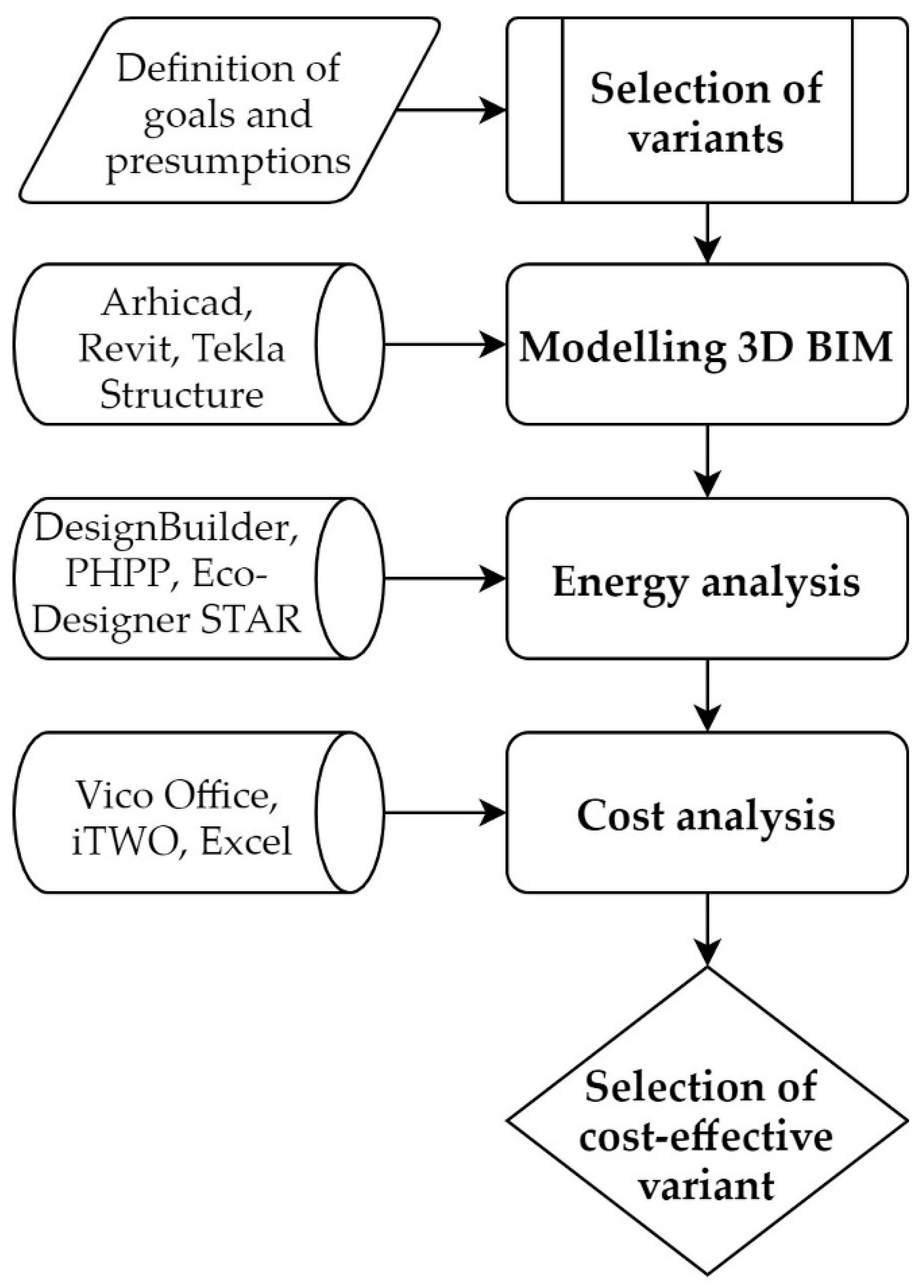
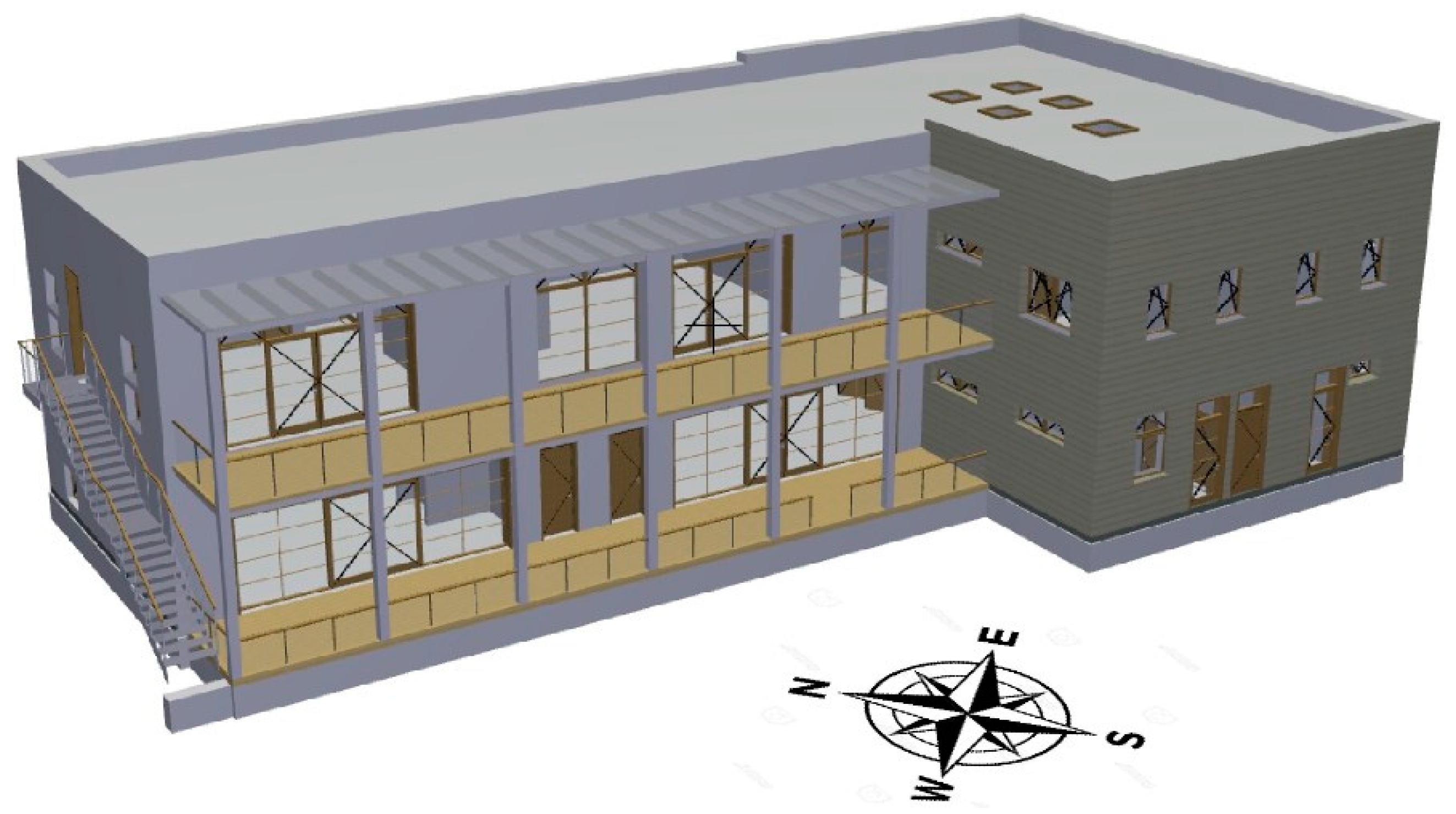
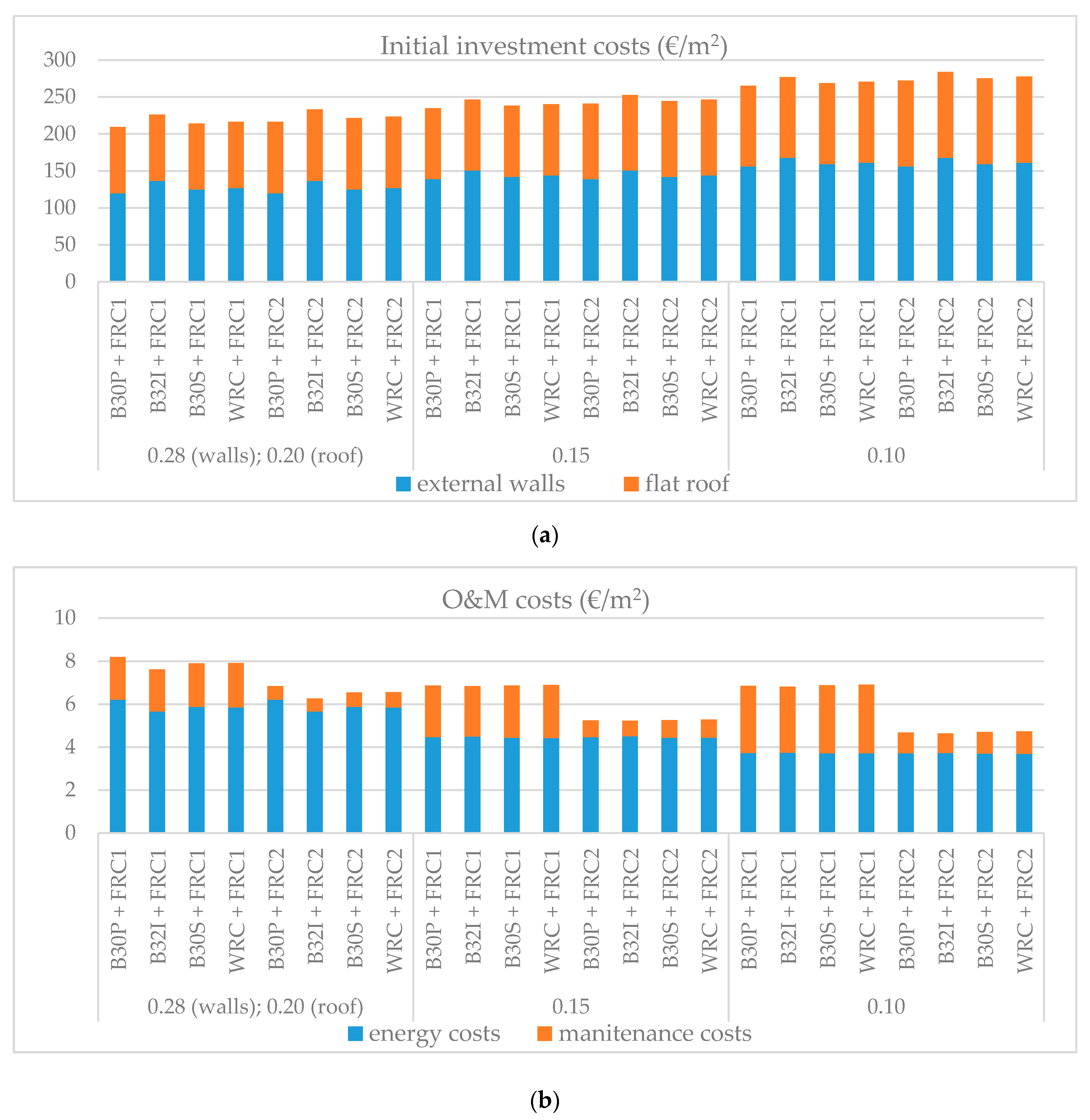
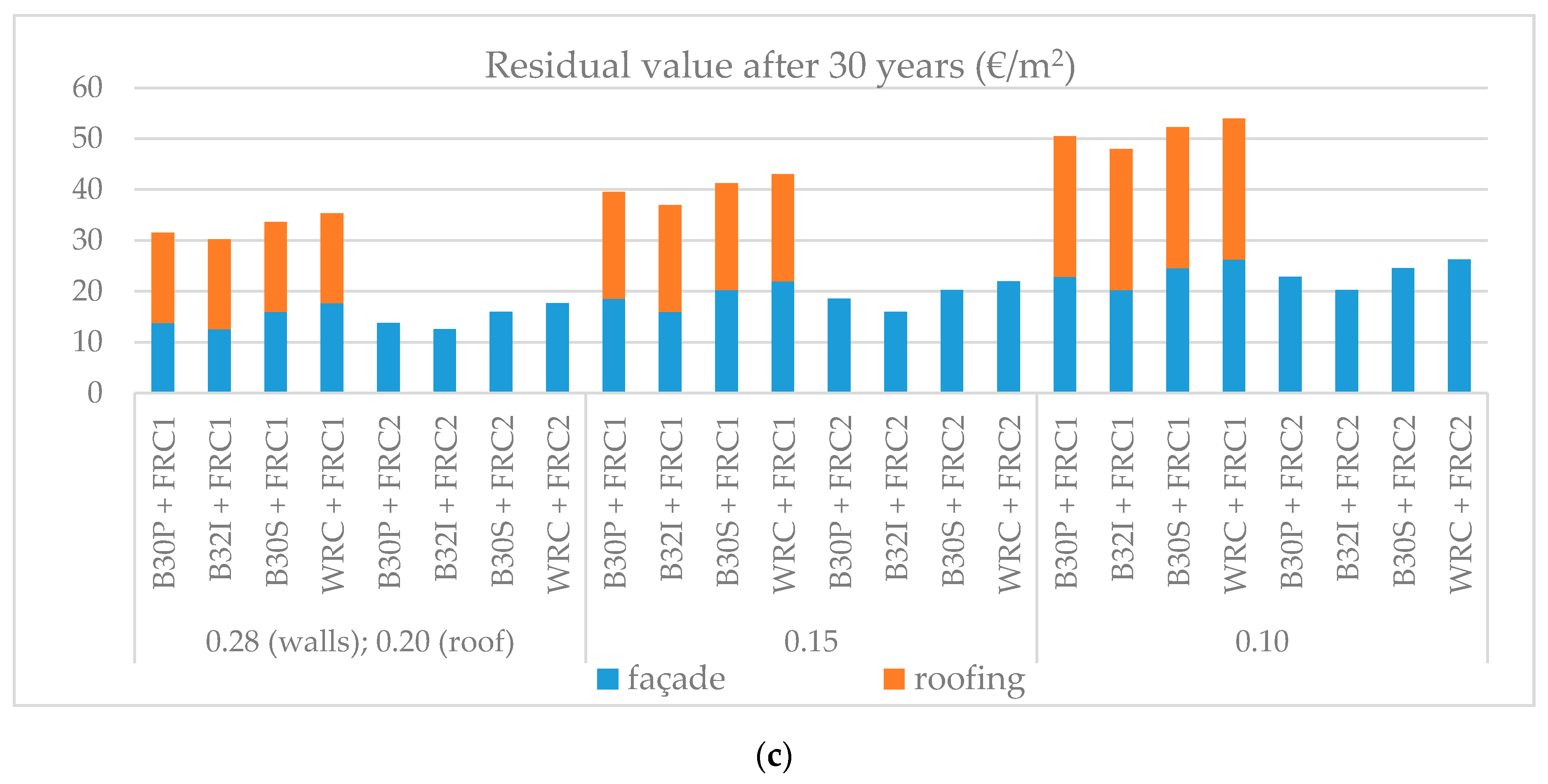
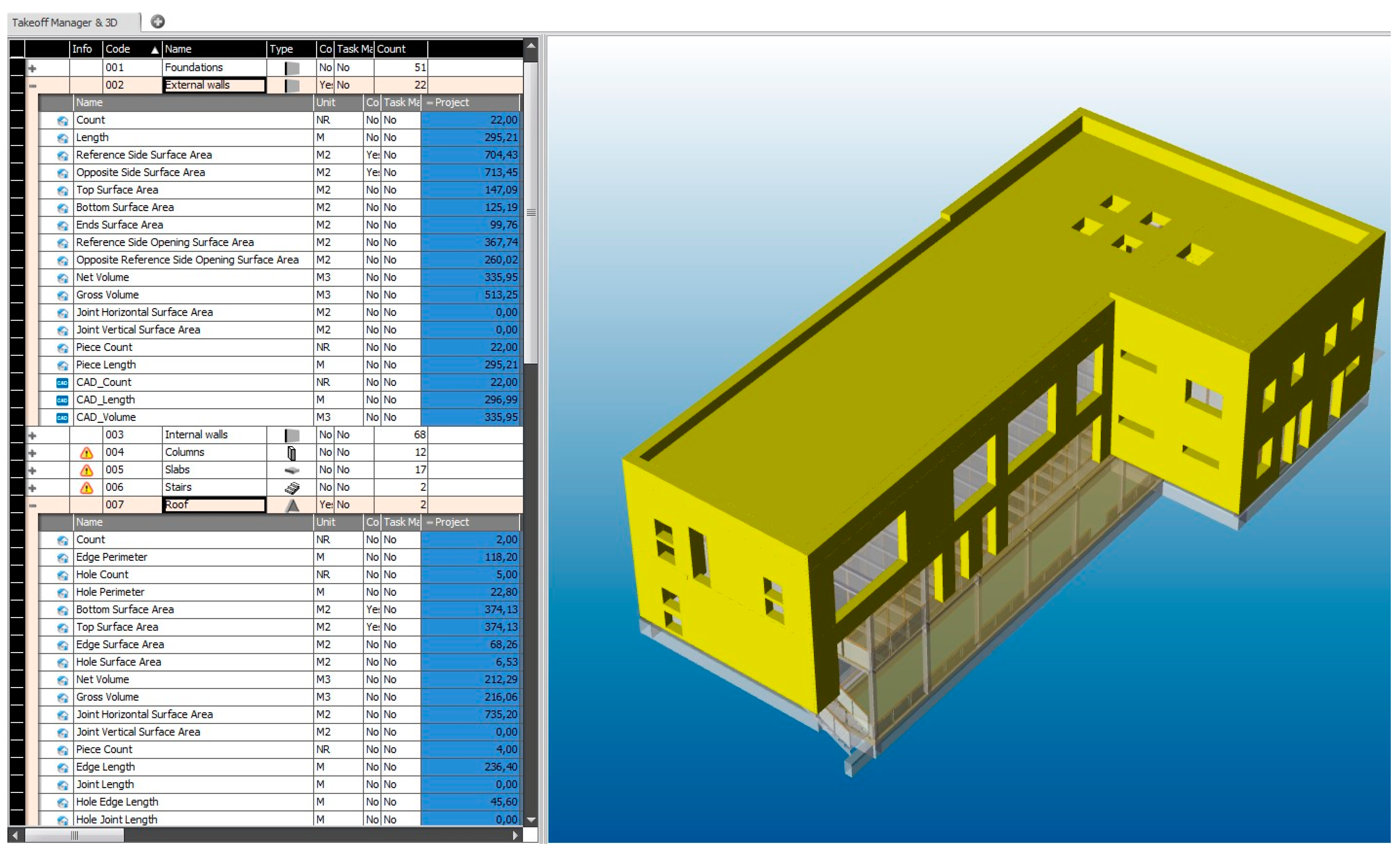
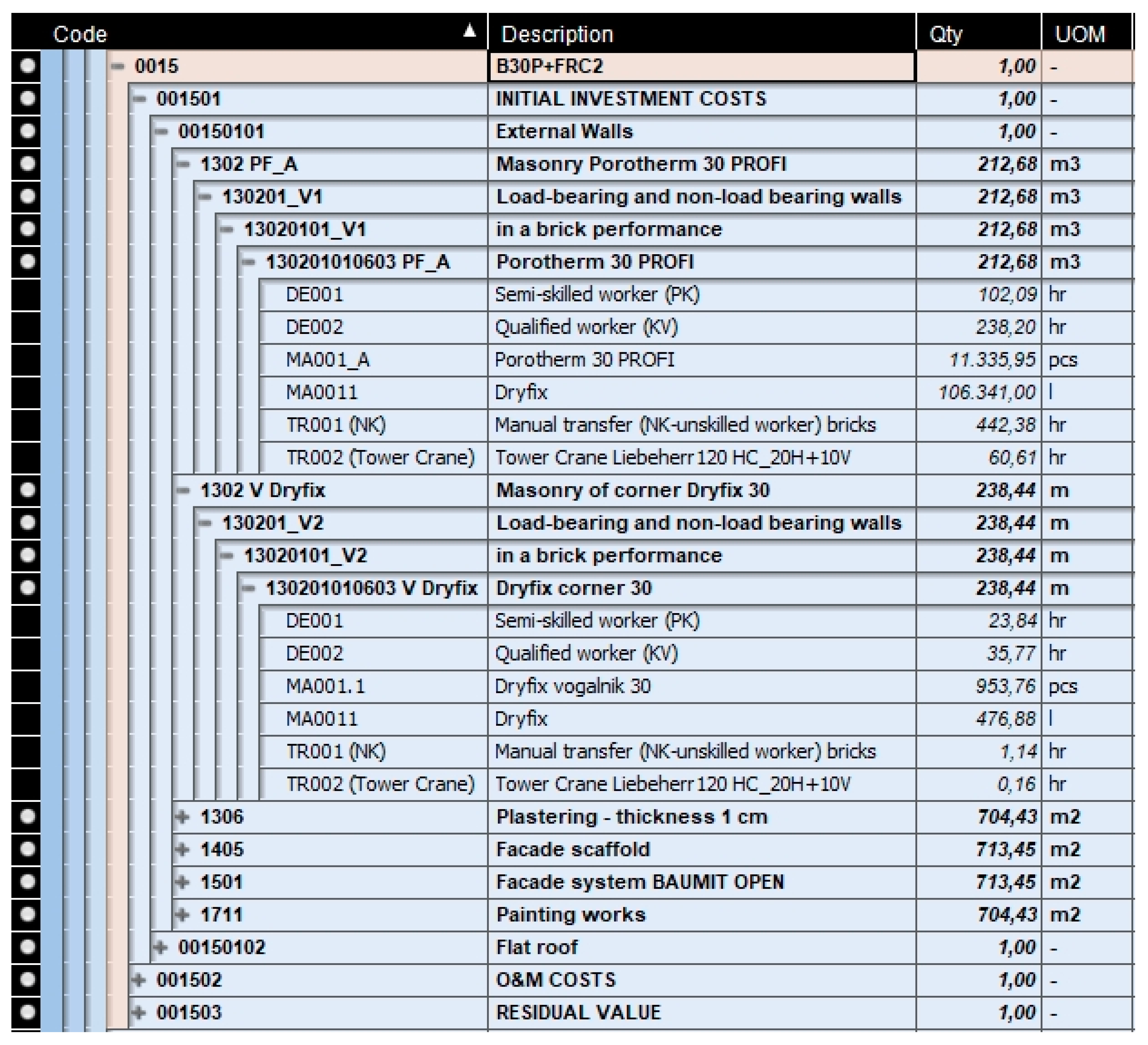
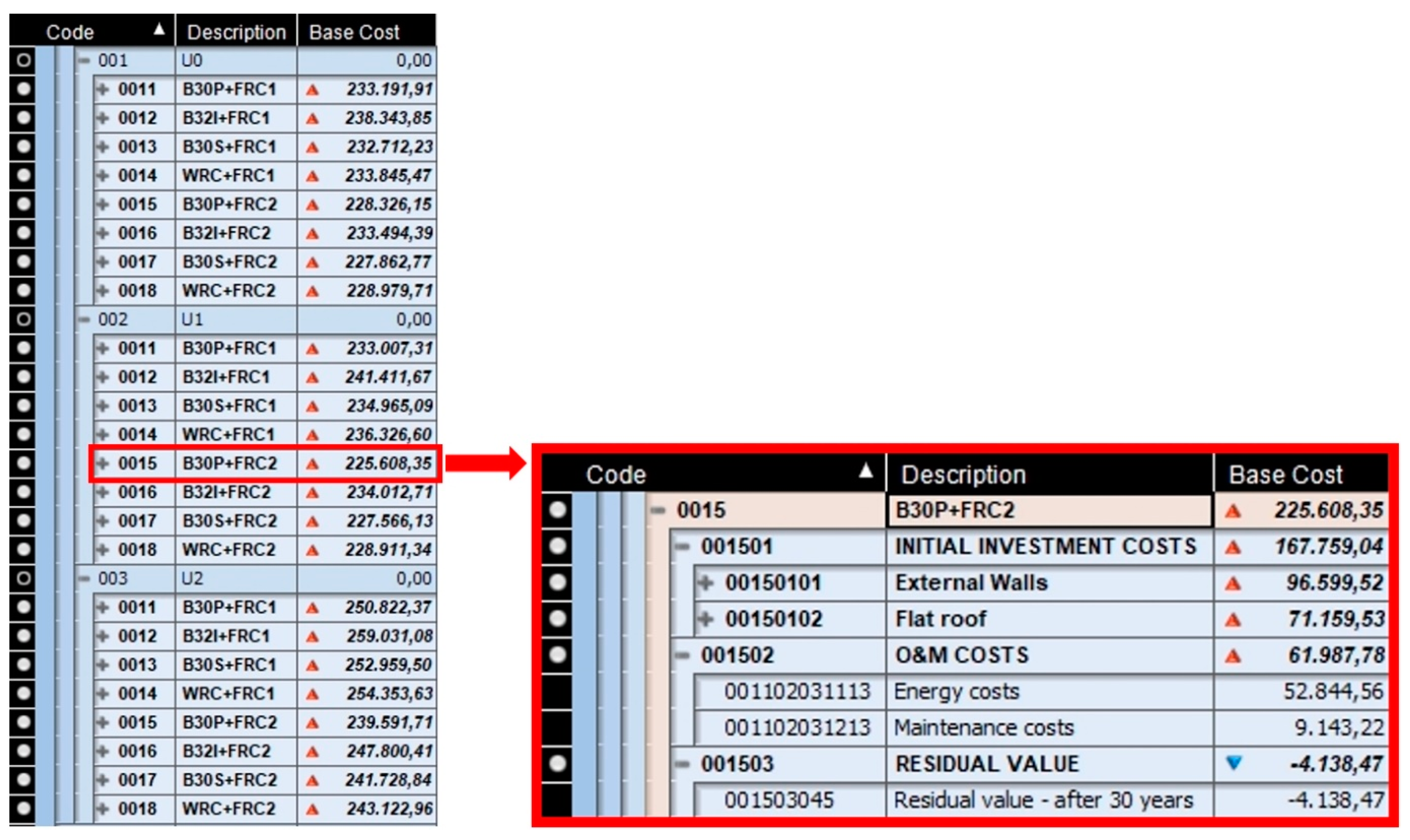
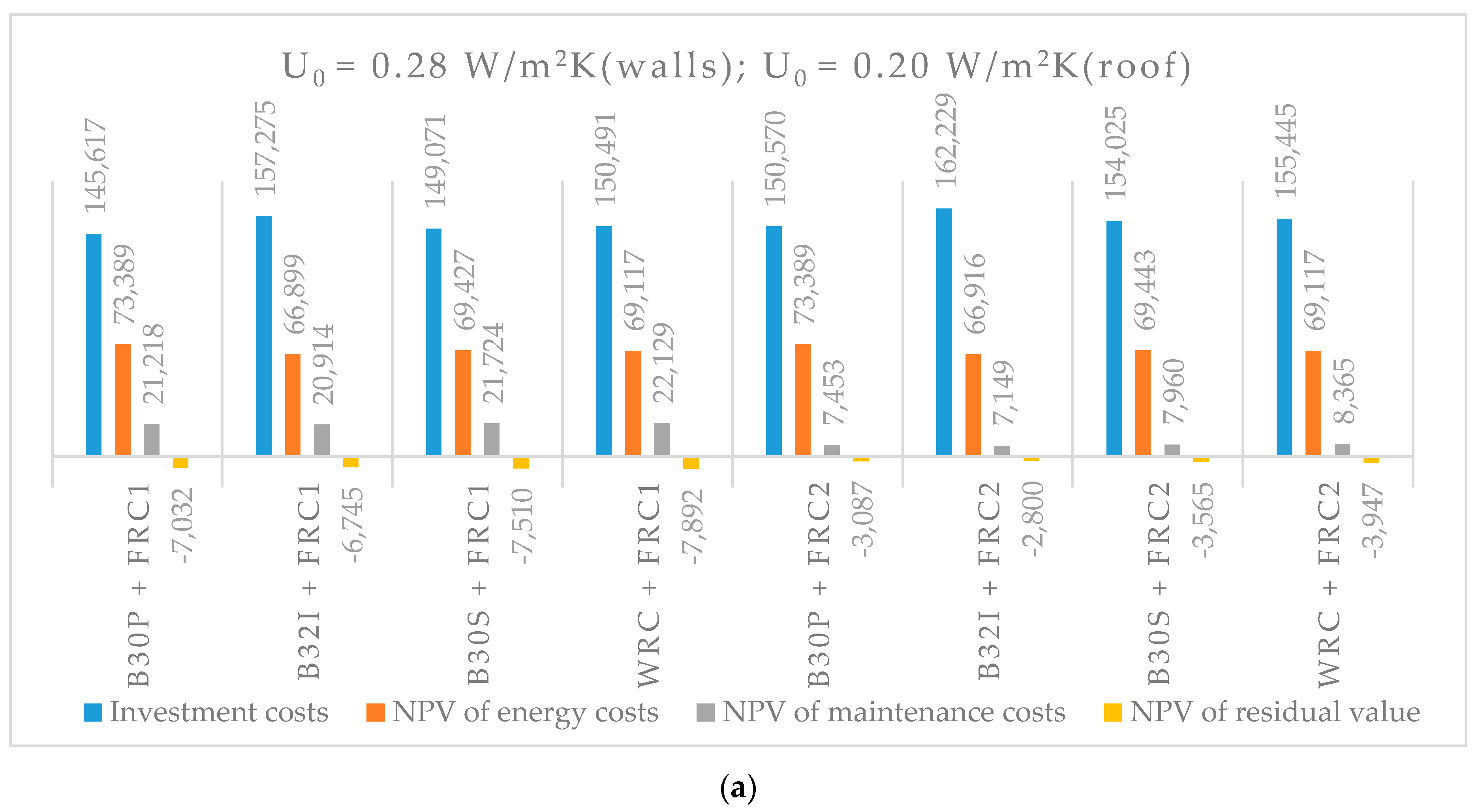
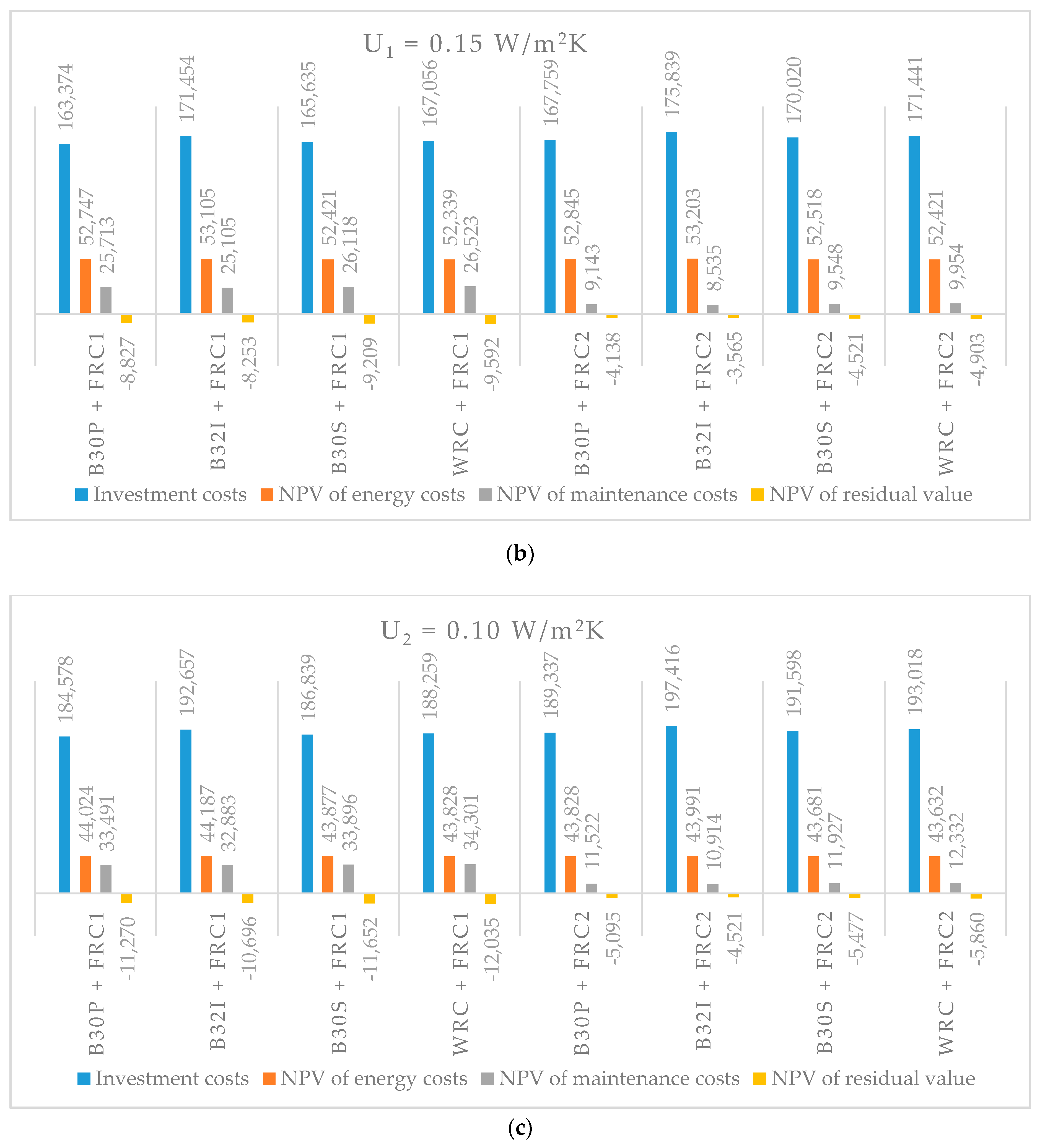
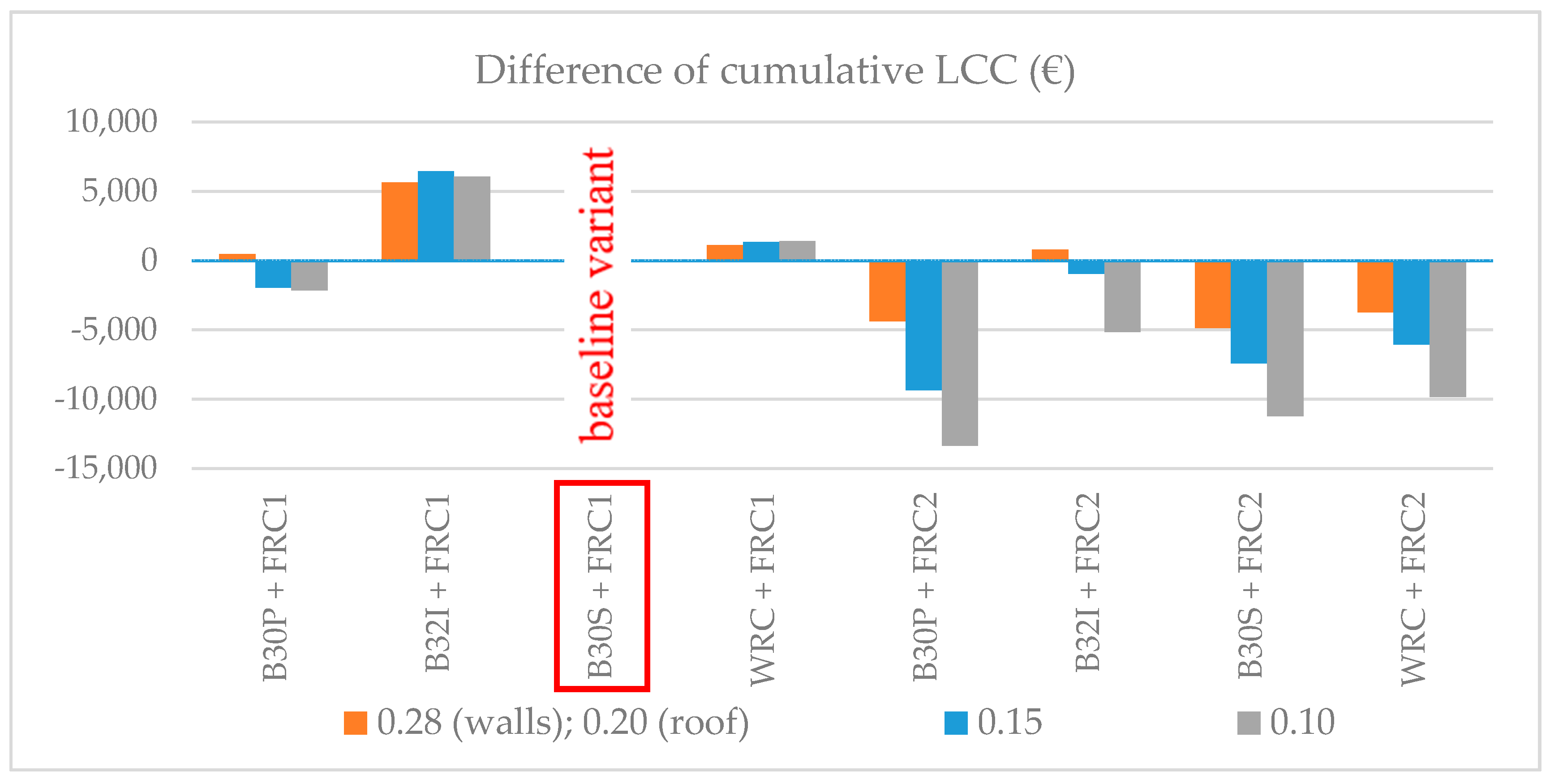
| B30P | B32I | B30S | WRC | |
|---|---|---|---|---|
| U0 | External wall plaster: λ = 0.54 W/mK, 2 cm Facade insulation board Baumit Open plus: λ = 0.032 W/mK, 3 cm Brick wall Porotherm 30 Profi: λ = 0.124 W/mK, 30 cm Internal finish plaster: λ = 0.35 W/mK, 1 cm Uactual = 0.28 W/m2K  | External wall plaster: λ = 0.54 W/mK, 2 cm Facade insulation board Baumit Open plus: λ = 0.032 W/mK, 0 cm Brick wall Porotherm 32 IZO Profi: λ = 0.077 W/mK, 32 cm Internal finish plaster: λ = 0.35 W/mK, 1 cm Uactual = 0.23 W/m2K  | External wall plaster: λ = 0.54 W/mK, 2 cm Facade insulation board Baumit Open plus: λ = 0.032 W/mK, 8 cmBrick wall Porotherm 30 S Plus: λ = 0.23 W/mK, 30 cm Internal finish plaster: λ = 0.35 W/mK, 1 cm Uactual = 0.27 W/m2K  | External wall plaster: λ = 0.54 W/mK, 2 cm Facade insulation board Baumit Open plus: λ = 0.032 W/mK, 12 cm RC wall: λ = 2.1 W/mK, 20 cm Internal finish plaster: λ = 0.35 W/mK, 1 cm Uactual = 0.27 W/m2K  |
| U1 | External wall plaster: λ = 0.54 W/mK, 2 cm Facade insulation board Baumit Open plus: λ = 0.032 W/mK, 14 cm Brick wall Porotherm 30 Profi: λ = 0.124 W/mK, 30 cm Internal finish plaster: λ = 0.35 W/mK, 1 cm Uactual = 0.14 W/m2K  | External wall plaster: λ = 0.54 W/mK, 2 cm Facade insulation board Baumit Open plus: λ = 0.032 W/mK, 8 cm Brick wall Porotherm 32 IZO Profi: λ = 0.077 W/mK, 32 cm Internal finish plaster: λ = 0.35 W/mK, 1 cm Uactual = 0.15 W/m2K  | External wall plaster: λ = 0.54 W/mK, 2 cm Facade insulation board Baumit Open plus: λ = 0.032 W/mK, 18 cm Brick wall Porotherm 30 S Plus: λ = 0.23 W/mK, 30 cm Internal finish plaster: λ = 0.35 W/mK, 1 cm Uactual = 0.15 W/m2K  | External wall plaster: λ = 0.54 W/mK, 2 cm Facade insulation board Baumit Open plus: λ = 0.032 W/mK, 22 cm RC wall: λ = 2.1 W/mK, 20 cm Internal finish plaster: λ = 0.35 W/mK, 1 cm Uactual = 0.15 W/m2K  |
| U2 | External wall plaster: λ = 0.54 W/mK, 2 cm Facade insulation board Baumit Open plus: λ = 0.032 W/mK, 24 cm Brick wall Porotherm 30 Profi: λ = 0.124 W/mK, 30 cm Internal finish plaster: λ = 0.35 W/mK, 1 cm Uactual = 0.10 W/m2K  | External wall plaster: λ = 0.54 W/mK, 2 cm Facade insulation board Baumit Open plus: λ = 0.032 W/mK, 18 cm Brick wall Porotherm 32 IZO Profi: λ = 0.077 W/mK, 32 cm Internal finish plaster: λ = 0.35 W/mK, 1 cm Uactual = 0.10 W/m2K  | External wall plaster: λ = 0.54 W/mK, 2 cm Facade insulation board Baumit Open plus: λ = 0.032 W/mK, 28 cm Brick wall Porotherm 30 S Plus: λ = 0.23 W/mK, 30 cm Internal finish plaster: λ = 0.35 W/mK, 1 cm Uactual = 0.10 W/m2K  | External wall plaster: λ = 0.54 W/mK, 2 cm Facade insulation board Baumit Open plus: λ = 0.032 W/mK, 32 cm RC wall: λ = 2.1 W/mK, 20 cm Internal finish plaster: λ = 0.35 W/mK, 1 cm Uactual = 0.10 W/m2K  |
| FRC1 | FRC2 | |
|---|---|---|
| U0 | Gypsum fibreboard λ = 0.21 W/mK, 1.25 cm RC slab: λ = 2.1 W/mK, 24 cm Multilayer waterproofing strips: λ = 0.19 W/mK, 1 cm, polyethylene (PE) foil Roof insulation board XPS: λ = 0.036 W/mK, 12 cm + λ = 0.033 W/mK, 4 cm Vapor permeable foil Layer of felt Layer of gravel: λ = 0.36 W/mK, 8 cm Uactual = 0.19 W/m2K  | Gypsum fibreboard λ = 0.21 W/mK, 1.25 cm RC slab: λ = 2.1 W/mK, 24 cm, Vapor barrier Roof insulation board SmartRoof: λ = 0.038 W/mK, 14 cm + 4 cm Layer of feltPolymeric waterproofing membrane: SikaplanSG Layer of felt Layer of gravel: λ = 0.36 W/mK, 8 cm Uactual = 0.20 W/m2K  |
| U1 | Gypsum fibreboard λ = 0.21 W/mK, 1.25 cm RC slab: λ = 2.1 W/mK, 24 cm Multilayer waterproofing strips: λ = 0.19 W/mK, 1 cm, polyethylene (PE) foil Roof insulation board XPS: λ = 0.036 W/mK, 12 cm + λ = 0.035 W/mK, 10 cm Vapor permeable foilLayer of felt Layer of gravel: λ = 0.36 W/mK, 8 cm Uactual = 0.15 W/m2K  | Gypsum fibreboard λ = 0.21 W/mK, 1.25 cm RC slab: λ = 2.1 W/mK, 24 cm Vapor barrier Roof insulation board SmartRoof: λ = 0.038 W/mK, 14 cm + 10 cm Layer of felt Polymeric waterproofing membrane: SikaplanSG Layer of felt Layer of gravel: λ = 0.36 W/mK, 8 cm Uactual = 0.15 W/m2K  |
| U2 | Gypsum fibreboard λ = 0.21 W/mK, 1.25 cm RC slab: λ = 2.1 W/mK, 24 cm Multilayer waterproofing strips: λ = 0.19 W/mK, 1 cm, polyethylene (PE) foil Roof insulation board XPS: λ = 0.036 W/mK, 2 × 12 cm + λ=0.035 W/mK, 10 cm Vapor permeable foil Layer of felt Layer of gravel: λ = 0.36 W/mK, 8 cm Uactual = 0.10 W/m2K  | Gypsum fibreboard λ = 0.21 W/mK, 1.25 cm RC slab: λ = 2.1 W/mK, 24 cm Vapor barrier Roof insulation board SmartRoof: λ = 0.038 W/mK, 14 cm + 14 cm + 10 cm Layer of feltPolymeric waterproofing membrane: SikaplanSG Layer of felt Layer of gravel: λ = 0.36 W/mK, 8 cm Uactual = 0.10 W/m2K  |
| U0 | U1 | U2 | ||||||||||
|---|---|---|---|---|---|---|---|---|---|---|---|---|
| (kWh/m2a) | B30P + FRC1 | B32I + FRC1 | B30S + FRC1 | WRC + FRC1 | B30P + FRC1 | B32I + FRC1 | B30S + FRC1 | WRC + FRC1 | B30P + FRC1 | B32I + FRC1 | B30S + FRC1 | WRC + FRC1 |
| Qh | 41.05 | 37.09 | 38.64 | 38.44 | 28.50 | 28.72 | 28.30 | 28.24 | 23.22 | 23.32 | 23.13 | 23.10 |
| Qc | 3.96 | 3.94 | 3.95 | 3.95 | 3.85 | 3.85 | 3.85 | 3.85 | 3.78 | 3.78 | 3.78 | 3.78 |
| Qh+c | 45.01 | 41.03 | 42.58 | 42.39 | 32.35 | 32.57 | 32.15 | 32.10 | 27.00 | 27.10 | 26.91 | 26.88 |
| (kWh/m2a) | B30P + FRC2 | B32I + FRC2 | B30S + FRC2 | WRC + FRC2 | B30P + FRC2 | B32I + FRC2 | B30S + FRC2 | WRC + FRC2 | B30P + FRC2 | B32I + FRC2 | B30S + FRC2 | WRC + FRC2 |
| Qh | 41.05 | 37.10 | 38.64 | 38.45 | 28.56 | 28.78 | 28.36 | 28.30 | 23.10 | 23.20 | 23.01 | 22.98 |
| Qc | 3.96 | 3.94 | 3.95 | 3.95 | 3.85 | 3.85 | 3.85 | 3.85 | 3.78 | 3.78 | 3.78 | 3.78 |
| Qh+c | 45.01 | 41.04 | 42.59 | 42.39 | 32.41 | 32.63 | 32.21 | 32.15 | 26.88 | 26.98 | 26.79 | 26.76 |
| Study Period | Years | 30 |
|---|---|---|
| Service Life (façade/roofing FRC1/roofing FRC2) | Years | 40/20/30 |
| Fraction of small repairs (in %) (façade/FRC1/FRC2) | % | 20/30/25 |
| Net heated floor area (Ah) | m2 | 695.68 |
| Discount rate, i | % | 4 |
| Energy price, Electricity | €/kWh | 0.138 |
© 2020 by the authors. Licensee MDPI, Basel, Switzerland. This article is an open access article distributed under the terms and conditions of the Creative Commons Attribution (CC BY) license (http://creativecommons.org/licenses/by/4.0/).
Share and Cite
Pučko, Z.; Maučec, D.; Šuman, N. Energy and Cost Analysis of Building Envelope Components Using BIM: A Systematic Approach. Energies 2020, 13, 2643. https://doi.org/10.3390/en13102643
Pučko Z, Maučec D, Šuman N. Energy and Cost Analysis of Building Envelope Components Using BIM: A Systematic Approach. Energies. 2020; 13(10):2643. https://doi.org/10.3390/en13102643
Chicago/Turabian StylePučko, Zoran, Damjan Maučec, and Nataša Šuman. 2020. "Energy and Cost Analysis of Building Envelope Components Using BIM: A Systematic Approach" Energies 13, no. 10: 2643. https://doi.org/10.3390/en13102643
APA StylePučko, Z., Maučec, D., & Šuman, N. (2020). Energy and Cost Analysis of Building Envelope Components Using BIM: A Systematic Approach. Energies, 13(10), 2643. https://doi.org/10.3390/en13102643





